

Estás aquí en el medio de la puerta de roca Punta Guadalupe en La Pared ... puedes encontrar el Earthcache adecuado AQUÍ. Aquí el desarrollo de las llamadas puertas de roca o puertas de surf está muy bien descrito. Pero no me preocupa la génesis, sino su destrucción o su erosión. En el, por ejemplo, Aunque Earthcache discutirá brevemente la erosión y la tectónica. Pero, ¿qué significa esto?

Ihr befindet euch hier mitten auf dem Felsentor Punta Guadalupe in La Pared… den dazu passenden Earthcache findet ihr HIER. Hier wird sehr gut die Entstehung sogenannter Felsentore bzw. Brandungstoren beschrieben. Mir geht’s aber nicht um die Entstehung, sondern um deren Zerstörung bzw. um deren Verwitterung. In dem o.g. Earthcache wird kurz auf das Thema Erosion und Tektonik eingegangen. Aber was ist dies?

You are here in the middle of the rock gate Punta Guadalupe in La Pared ... you can find the suitable Earthcache Here. Here the development of so-called rock gates or surf gates is very well described. But I'm not concerned with the genesis, but with their destruction or their weathering. In the o.g. Although Earthcache will briefly discuss erosion and tectonics. But what does this mean?
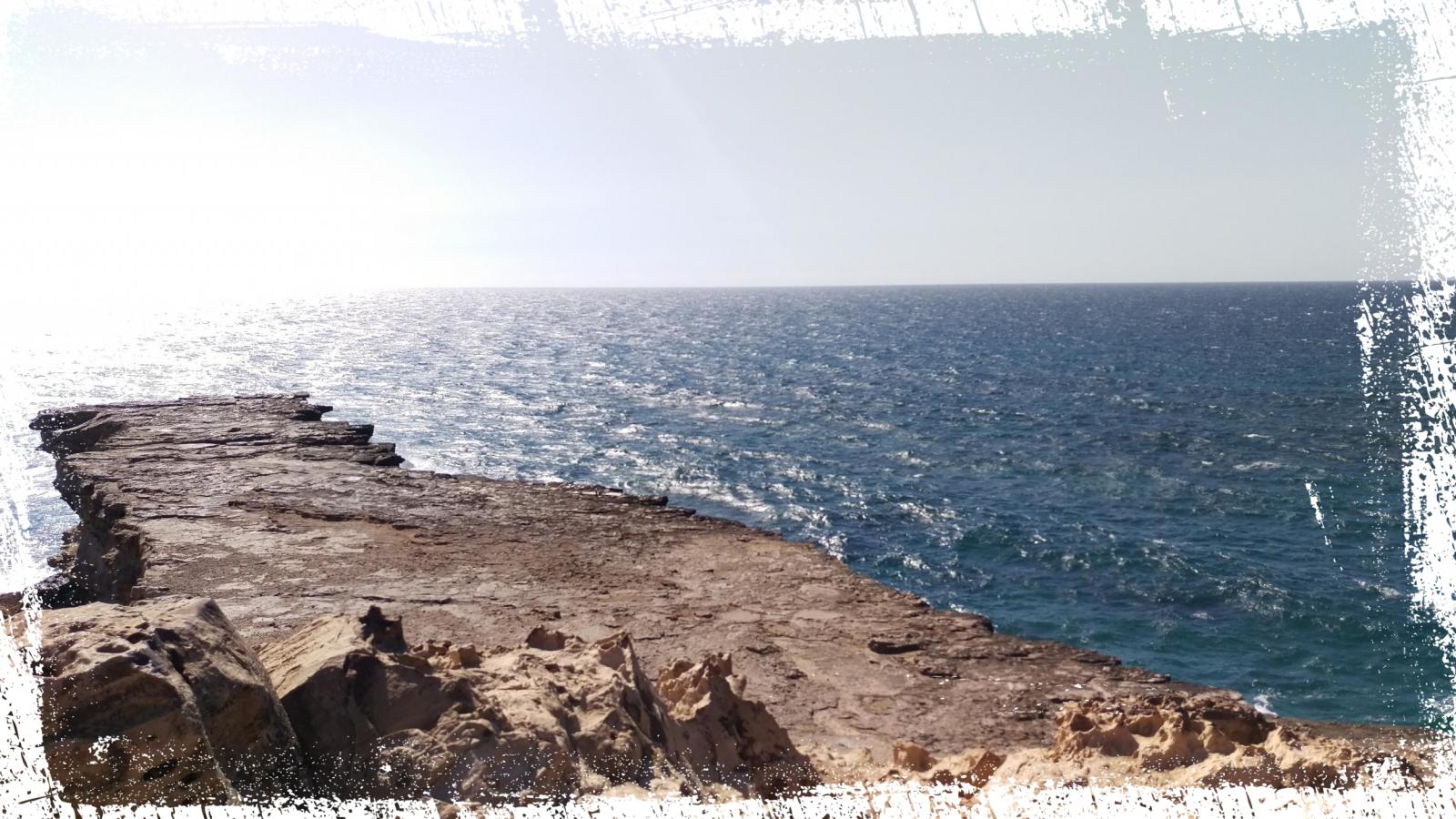

La erosión es un proceso fundamental en la parte exógena del ciclo de las rocas. Se trata de la eliminación de las rocas más o menos degradado o sedimentos sueltos, incluyendo las plantas. Por lo tanto, la erosión crea una mano accidentes geográficos, como montañas y valles, pero destruyó selbige finalmente con el trabajo continuado plenamente, si vosotros no hay procesos endógenos (especialmente tectónica), causando contrarrestar un aumento de la superficie de la tierra. La erosión es la contraparte de la sedimentación. En distinción erosión se hace sustancialmente entre línea como (lineal) y la erosión superficial. Bajo su erosión lineal se refiere a la profundización de la superficie de la tierra por el agua que fluye en pequeños riachuelos, arroyos o de corta duración. Otro momento, y menos extendida en la Tierra forman su erosión lineal se realiza por los glaciares de montaña (Exaration o erosión glacial). Las formas del valle producidos son en forma de V en fluvial y en forma de U en la erosión glacial.
La meteorización en las geociencias se refiere a la descomposición natural de las rocas como resultado de su ubicación expuesta en la superficie de la tierra o cerca de ella. Varios procesos se combinan para provocar la destrucción física y / o la alteración química de la roca (que es abiótica o biótica). Dependiendo del tipo de meteorización, los minerales formadores de rocas se conservan (resistencia a la intemperie) o se disuelven o convierten (meteorización química). En terrenos uniformes, los productos de la intemperie de piedra forman capas superficiales sueltas, que se llaman regolito. En las pendientes, por otro lado, los productos de intemperismo se eliminan rápidamente (erosión) y se depositan en otro lugar como sedimento. Los procesos de intemperie de la construcción y las obras de arte hechas de piedra natural se conocen popularmente como tallado en piedra. En términos generales, "intemperismo" se entiende que significa la descomposición natural de los materiales que están expuestos a la influencia directa del clima. Además de rocas, esto también se aplica a materiales orgánicos como madera, materiales metálicos, vidrio y cerámica.
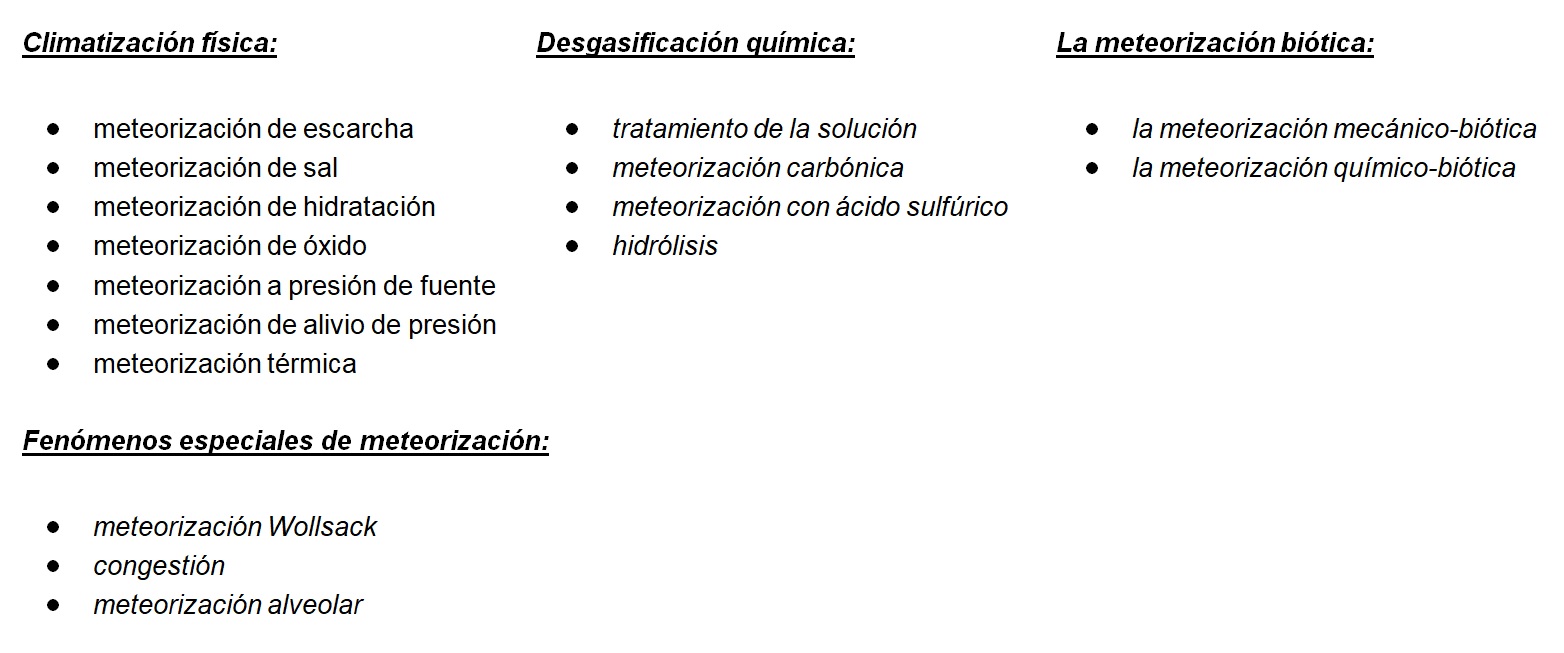

Die Erosion ist ein grundlegender Prozess im exogenen Teil des Gesteinskreislaufes. Er beinhaltet die Abtragung von mehr oder weniger stark verwitterten Gesteinen oder Lockersedimenten einschließlich der Böden. So erschafft die Erosion einerseits Geländeformen wie Berg und Tal, zerstört selbige jedoch schließlich bei anhaltendem Wirken vollständig, insofern ihr keine endogenen Prozesse (insbesondere Tektonik), die eine Anhebung der Landoberfläche hervorrufen, entgegenwirken. Erosion ist das Gegenstück zur Sedimentation. Bei Erosion wird im Wesentlichen zwischen linienhafter (linearer) und flächenhafter Erosion unterschieden. Unter linienhafter Erosion versteht man die Eintiefung der Erdoberfläche durch abfließendes Wasser in kleinen, kurzlebigen Rinnsalen oder in Fließgewässern. Eine andere und derzeit auf der Erde weniger weit verbreitete Form linienhafter Erosion erfolgt durch Gebirgsgletscher (Exaration oder Glazialerosion). Die entstehenden Talformen sind V-förmig bei fluviatiler und U-förmig bei glazialer Erosion.
Verwitterung bezeichnet in den Geowissenschaften die natürliche Zersetzung von Gestein infolge dessen exponierter Lage an oder nahe der Erdoberfläche. Dabei spielen mehrere Prozesse zusammen, die eine physikalische Zerstörung und/oder die chemische Veränderung des Gesteins (die abiotisch oder biotisch verursacht wird) herbeiführen. Je nach Art der Verwitterung bleiben die gesteinsbildenden Minerale erhalten (physikalische Verwitterung) oder werden aufgelöst oder umgewandelt (chemische Verwitterung). In ebenem Terrain bilden die Produkte der Gesteinsverwitterung lockere Oberflächenschichten, die als Regolith bezeichnet werden. In Hanglagen werden die Verwitterungsprodukte hingegen zügig abgeführt (Erosion) und an anderer Stelle als Sediment wieder abgelagert. Die Verwitterungsprozesse an Bau- und Kunstwerken aus Naturstein werden populär auch als Steinfraß bezeichnet. Allgemeinsprachlich wird unter „Verwittern“ die natürliche Zersetzung von Materialien, die dem direkten Einfluss der Witterung ausgesetzt sind, verstanden. Dies betrifft neben Gestein auch organische Materialien wie Holz sowie metallische Werkstoffe, Glas und Keramik.
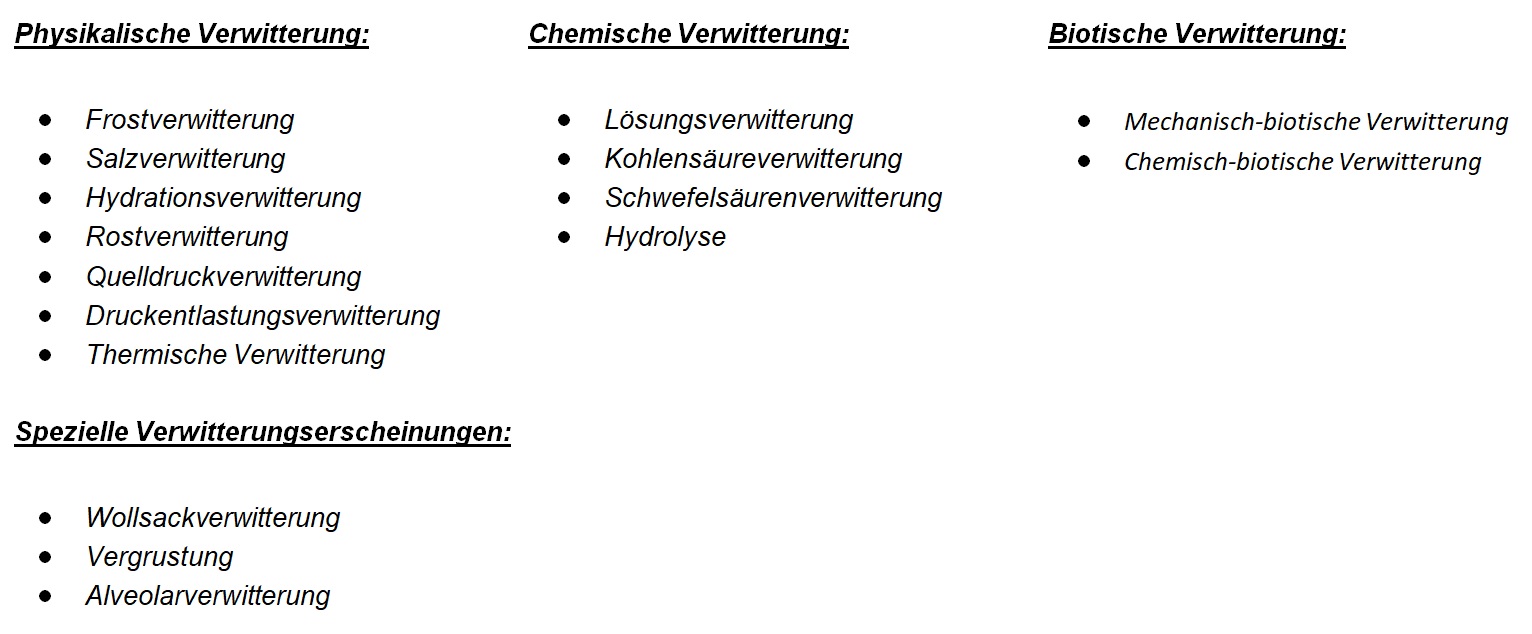

Erosion is a fundamental process in the exogenous part of the rock circuit. It involves the erosion of more or less heavily weathered rocks or loose sediments including soils. On the one hand, erosion creates terrain forms such as mountains and valleys, but eventually destroys them completely in continuous activity, insofar as they do not counteract any endogenous processes (especially tectonics) that cause an increase in the land surface. Erosion is the counterpart to sedimentation. In the case of erosion, a distinction is essentially made between linear (linear) and areal erosion. Linear erosion is understood to mean the deepening of the surface of the earth by outflowing water in small, short-lived rivulets or in flowing waters. Another form of linear erosion that is less widespread on earth today is through mountain glaciers (exaration or glacial erosion). The resulting valley shapes are V-shaped in fluviatile and U-shaped in glacial erosion.
Weathering in the geosciences refers to the natural decomposition of rocks as a result of their exposed location at or near the surface of the earth. Several processes combine to bring about physical destruction and / or chemical alteration of the rock (which is abiotic or biotic). Depending on the type of weathering, the rock-forming minerals are preserved (physical weathering) or are dissolved or converted (chemical weathering). In even terrain, the products of the stone weathering form loose surface layers, which are called regolith. On slopes, on the other hand, the weathering products are quickly removed (erosion) and deposited elsewhere as sediment. The weathering processes of building and works of art made of natural stone are popularly referred to as stone carving. Generally speaking, "weathering" is understood to mean the natural decomposition of materials which are exposed to the direct influence of the weather. In addition to rocks, this also applies to organic materials such as wood as well as metallic materials, glass and ceramics.

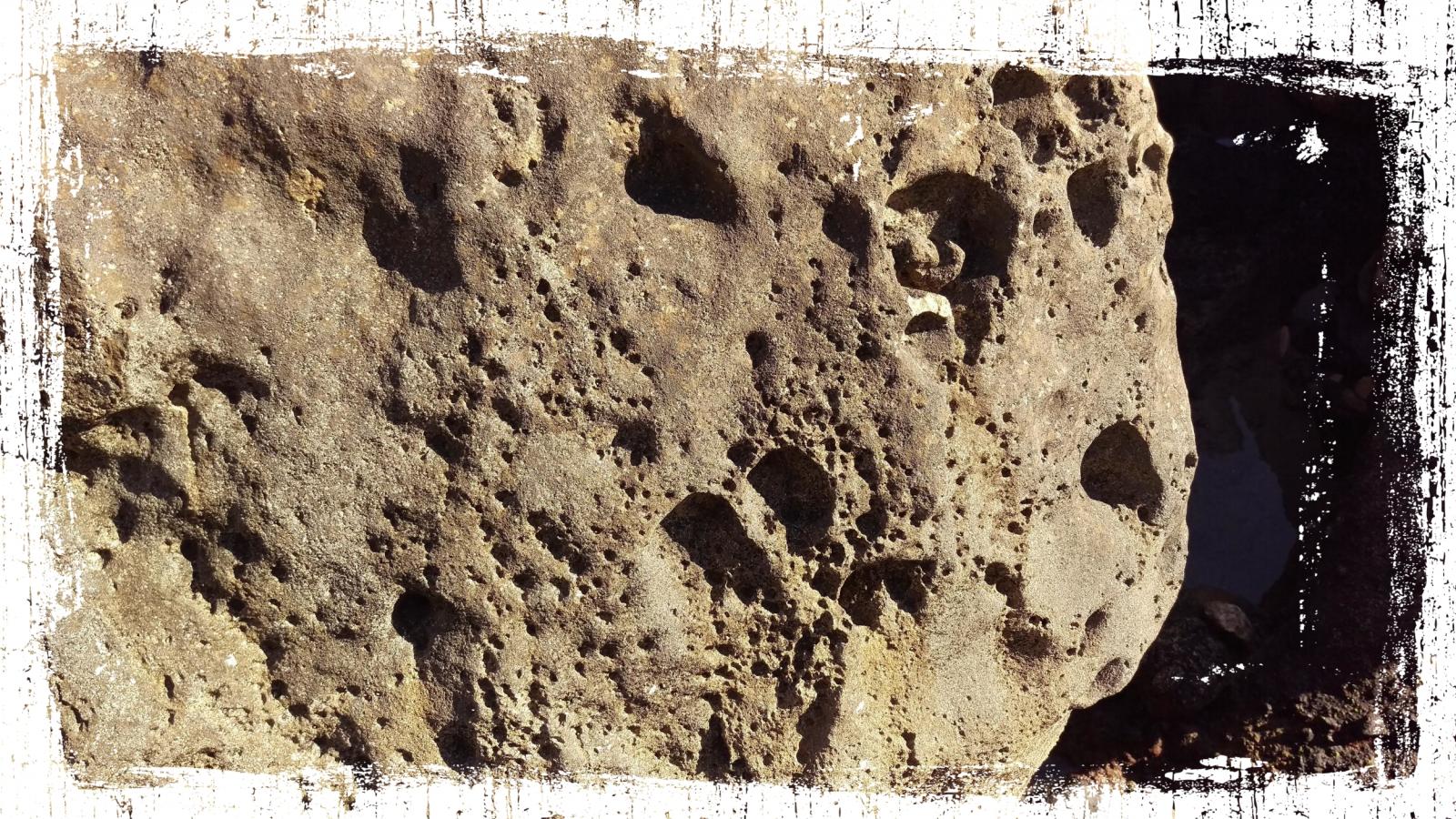
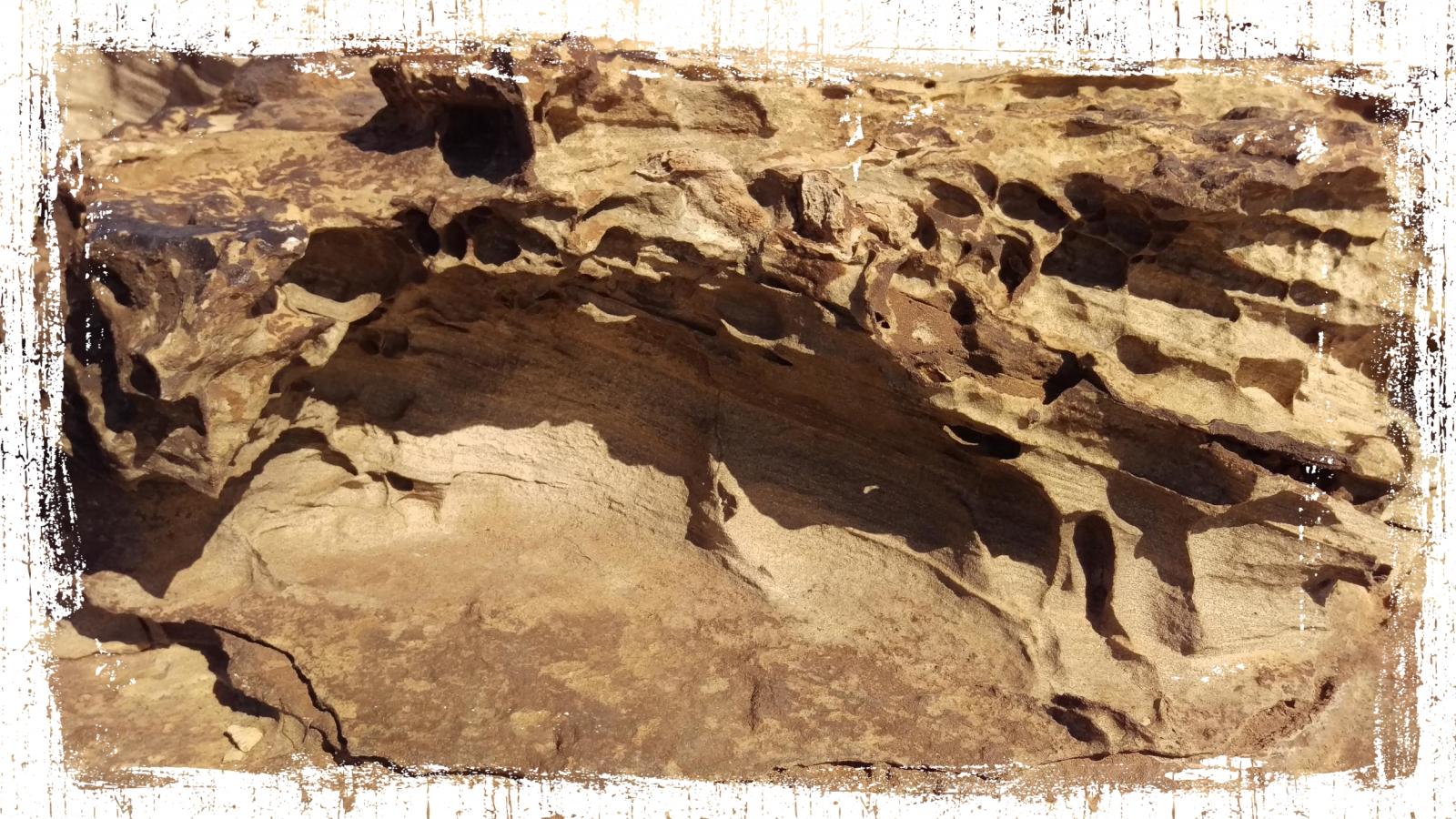

Estas fueron algunas breves bases de conocimiento para Earthcache. Si miras más de cerca el suelo debajo de tus pies, descubrirás muchos agujeros aislados en los que se ha depositado una sustancia blanca. Sí, claro ... esto es solo sal. Esta forma de meteorización llamada Tafoni es causada por la meteorización química y física simultánea del agua salada. La meteorización salina ocurre especialmente en áreas libres de heladas con tiempos secos pronunciados.
Por lo tanto, me gustaría hablar sobre la meteorización salina en particular. El efecto de Gelifracción por el crecimiento de cristales de hielo es muy similar al efecto del crecimiento de cristales de sal en las grietas y poros en la roca. El agua de mar se pasa a través de las mareas en la playa y roca piscinas rocosas y se evapora bajo el sol abrasador de una manera natural. De acuerdo con la solución salina depositar resultado, las sales precipitan fuera de la solución sobresaturada pronto: primero yeso / anhidrita, a continuación, sal de roca (sal de mesa), sales de potasio y de magnesio en el extremo (la intemperie sal). En las cavidades de las rocas, las sales se precipitan y se cristalizan a medida que la concentración de sal en la solución aumenta como resultado de la evaporación, o cuando la temperatura de una solución casi saturada disminuye. La presión de cristalización dirigida resultante ataca mecánicamente a la roca. El proceso es particularmente efectivo mediante la humectación repetida (meteorización por hidratación) y la desecación, por lo que encuentra su mayor difusión en áreas húmedas. El mismo proceso también se puede observar en bloques de construcción y concreto en las ciudades. La sal del camino, que se extiende por las carreteras en invierno, provoca un deterioro considerable de la superficie de los edificios de piedra y hormigón en el nivel del suelo. La meteorización salina se asocia generalmente con climas áridos, ya que allí el gran calor conduce a una evaporación muy fuerte. Puedes ver esta forma de desgaste pero también en las costas muy bien, especialmente en paredes o rocas que sobresalen en el mar.

Dies waren einige kurze Wissensgrundlagen für den Earthcache. Wenn Ihr euch hier mal etwas genauer den Boden unter euren Füßen anschaut, werdet Ihr viele vereinzelte Löcher entdecken, in denen sich eine weiße Substanz abgelagert hat. Ja, richtig…hierbei handelt es sich schlicht und einfach um Salz. Daher möchte ich im speziellen etwas auf die Salzverwitterung eingehen. Diese Tafoni genannte Verwitterungsform entsteht durch gleichzeitige chemische und physikalische Verwitterung durch das Salzwasser. Die Salzverwitterung tritt vor allem in frostfreien Gebieten mit ausgeprägten Trockenzeiten auf.
Der Wirkung der Frostverwitterung durch wachsende Eiskristalle sehr ähnlich ist der Effekt des Wachstums von Salzkristallen in Spalten und Poren des Gesteins. Das Meerwasser wird durch die Gezeiten an den steinigen Strand und Steinbecken geleitet und unter der gleißenden Sonne auf natürlichem Weg eingedampft. Entsprechend der salinaren Abscheidungsfolge fallen die Salze aus der bald übersättigten Lösung aus: zuerst Gips/Anhydrit, dann Steinsalz (Kochsalz), Kali- und Magnesiumsalze zum Schluss (Salzverwitterung). In Gesteinshohlräumen werden Salze ausgeschieden und kristallisieren, sobald die Salzkonzentration in der Lösung in Folge der Verdunstung ansteigt, oder wenn die Temperatur einer beinahe gesättigten Lösung sinkt. Der dabei entstehende, gerichtete Kristallisationsdruck, greift das Gestein mechanisch an. Der Prozess wird durch wiederholtes Befeuchten (Hydratationsverwitterung) und Austrocknen besonders wirksam, findet also in wechselfeuchten Gebieten seine größte Verbreitung. Denselben Prozess kann man auch an Bausteinen und Beton in den Städten beobachten. Streusalz, das im Winter auf Straßen ausgestreut wird, führt zu beachtlichem Zerfall des bodennahen Bereichs von Stein- und Betonbauten. Die Salzverwitterung wird meist mit ariden Klimaten in Verbindung gebracht, da dort die große Hitze zu sehr starken Verdunstungen führt. Man kann diese Form der Verwitterung aber auch an Küsten sehr gut erkennen, besonderes bei Mauern oder Felsen, die in das Meer ragen.

These were some brief knowledge bases for Earthcache. If you take a closer look at the ground beneath your feet, you will discover many isolated holes in which a white substance has deposited. Yeah, right ... this is just salt. This weathering form called Tafoni is caused by simultaneous chemical and physical weathering by the salt water. The salt weathering occurs especially in frost-free areas with pronounced dry times.
Therefore, I would like to talk about salt weathering in particular. Very similar to the effect of frost weathering by growing ice crystals is the effect of growth of salt crystals in crevices and pores of the rock. The seawater is led by the tides to the stony beach and stone pools and evaporated under the blazing sun in a natural way. According to the saline deposition sequence, the salts precipitate out of the soon supersaturated solution: first gypsum / anhydrite, then rock salt (common salt), potash and magnesium salts at the end (salt weathering). In rock cavities, salts are precipitated and crystallized as the salt concentration in the solution increases as a result of evaporation, or as the temperature of an almost saturated solution decreases. The resulting, directed crystallization pressure mechanically attacks the rock. The process is particularly effective by repeated moistening (hydration weathering) and drying out, so finds its greatest spread in humid areas. The same process can also be observed in building blocks and concrete in the cities. Road salt, which is spread on roads in winter, leads to considerable decay of the ground-level area of stone and concrete buildings. The salt weathering is usually associated with arid climates, since there the great heat leads to very strong evaporation. You can see this form of weathering but also on coasts very well, especially in walls or rocks that protrude into the sea.
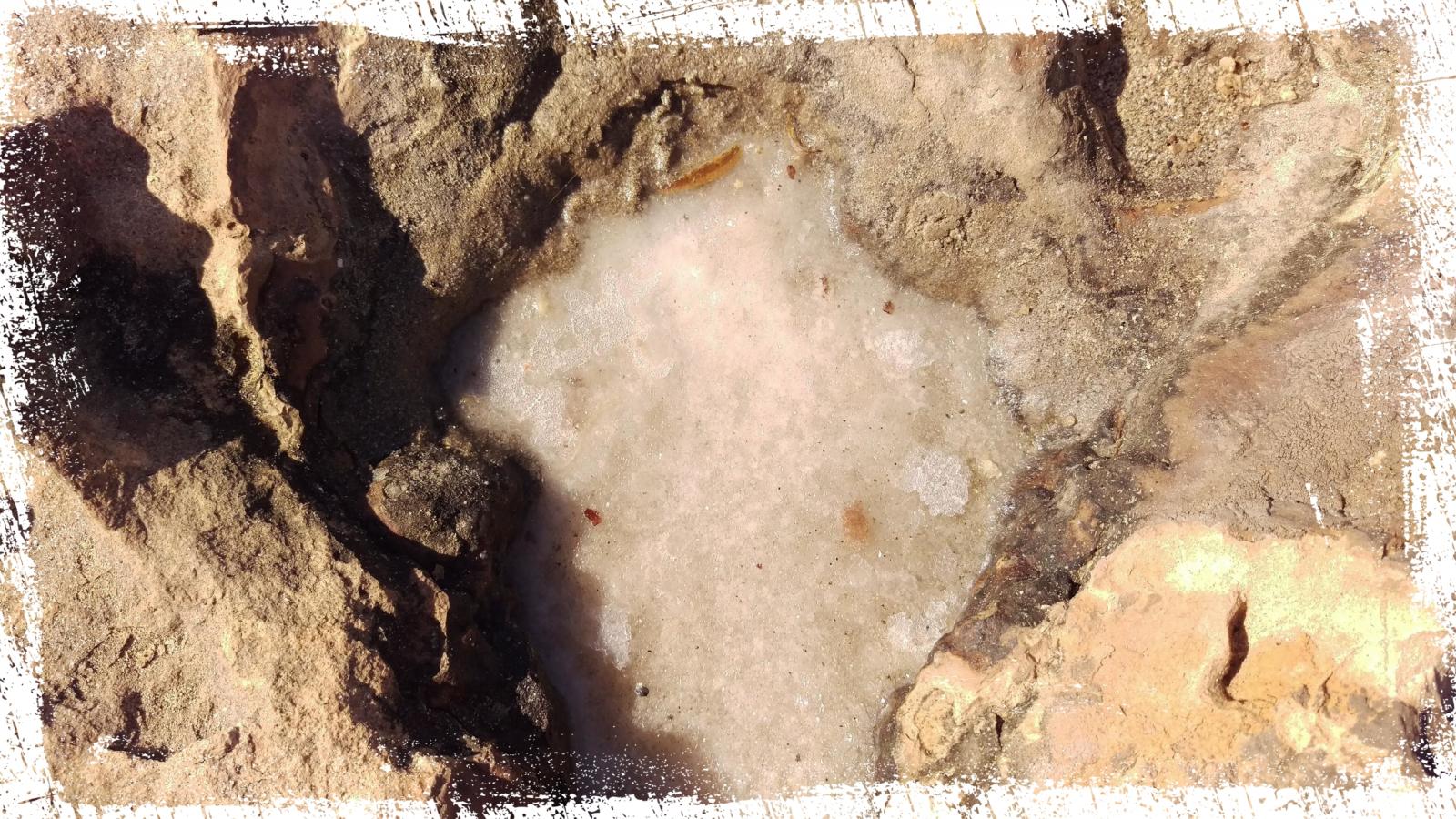
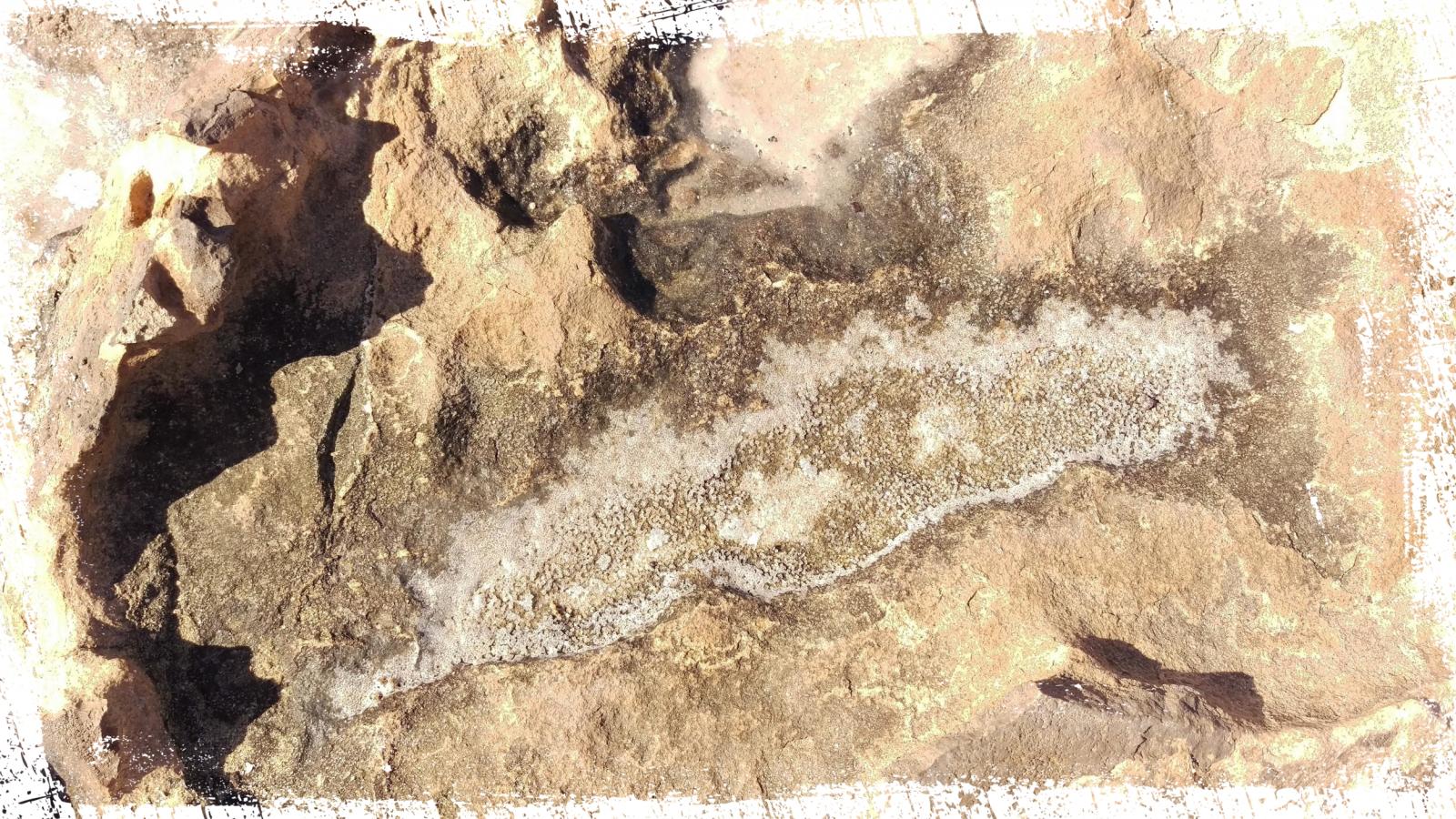
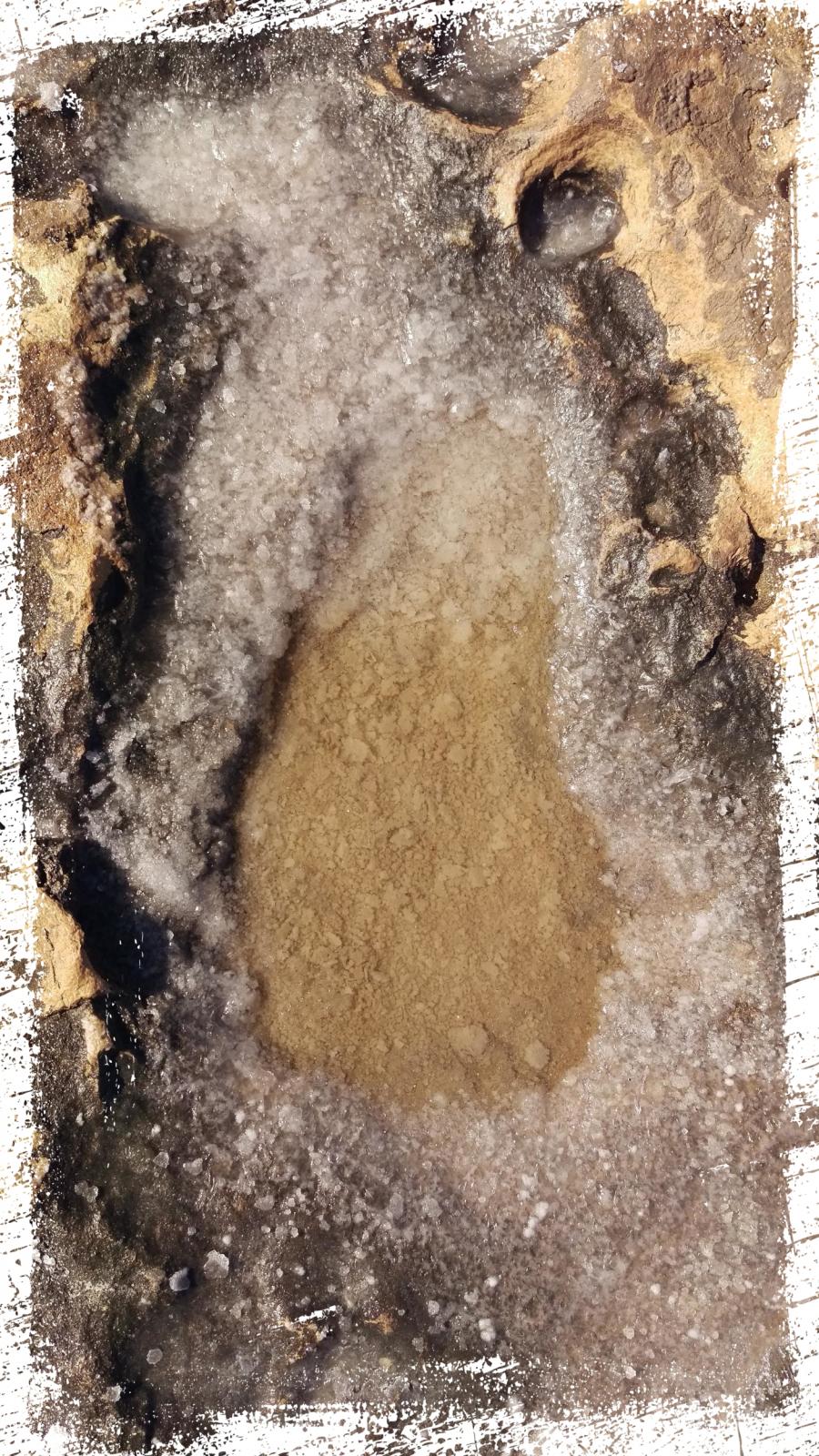

Pero ahora a la actual ... de acuerdo con el actual Earthcache directrices, usted debe ser capaz de registrar la visita de este Earthcache inmediatamente. Paralelo a esto, envíe un e-mail a geo.kiessel@web.de con el tema " Destrucción de la puerta de la roca " y responda a las siguientes preguntas:
1. Alrededor de las coordenadas de la lista debe descubrir las Tafones descritas anteriormente. ¿Cuánto estima su forma y diámetro?
2. ¿Qué piensas, por qué aquí en la parte superior de la plataforma, la meteorización salina está presente, a pesar de que la roca no tiene contacto con el agua del mar? ¡Justifica tu respuesta!
3. ¡Describe brevemente el tamaño y el estado de la sal depositada en el Tafonen!
4. ¡Agregue una foto suya y / o su GPS a su registro en las coordenadas dadas!
NOTA: Las fotos ya no son opcionales con el cambio de las Pautas de Earthcache del 10.06.2019, pueden ser una condición de registro, por lo tanto, todos los registros sin una foto se eliminarán en el futuro.
Si las respuestas no son correctas, me pondré en contacto con usted.

Nun aber zum eigentlichen...nach den aktuellen Earthcache-Guidelines dürft Ihr den Besuch dieses Earthcaches sofort loggen. Parallel dazu sendet bitte eine E-Mail an geo.kiessel@web.de mit dem Betreff: „Destrucción de la puerta de la roca“ und beantwortet mir folgende Fragen:
1. Rings um die Listingkoordinaten solltest du die oben beschriebenen Tafone entdecken. Wie groß schätzt du deren Form und Durchmesser?
2. Was denkst du, wieso hier oben auf der Plattform die Salzverwitterung vorliegt, obwohl das Gestein gar keinen Kontakt zum Meerwasser hat? Begründe deine Antwort!
3. Beschreibe kurz die Größe und Beschaffenheit des in den Tafonen abgelegerten Salzes!
4.Füge deinem Log ein Foto von Euch oder/und Eurem GPS an den angegebenen Koordinaten hinzu!
HINWEIS: Fotos sind mit der Änderung der Earthcache-Guidelines vom 10.06.2019 nicht mehr zwingend optional, sie dürfen eine Logbedingung sein! Daher werden alle Logs ohne Foto in Zukunft gelöscht.
Falls die Antworten nicht stimmen, setze ich mich mit Euch in Verbindung.

But now to the actual ... according to the current Earthcache Guidelines, you should be able to log the visit of this Earthcache immediately. Parallel to this, please send an e-mail to geo.kiessel@web.de with the subject " Destrucción de la puerta de la roca " and answer the following questions:
1. Around the listing coordinates you should discover the Tafones described above. How much do you estimate their shape and diameter?
2. What do you think, why here at the top of the platform, the salt weathering is present, although the rock has no contact with the sea water? Justify your answer!
3. Describe briefly the size and condition of the salt deposited in the Tafonen!
4. Add a photo of yourself and / or your GPS to your log at the given coordinates!
NOTE: Photos are no longer optional with the change of the Earthcache-Guidelines from 10.06.2019, they may be a logging condition, therefore all logs without a photo will be deleted in future.
If the answers are not correct, I will contact you.
Diviértete explorando el kiessel
Viel Spaß beim Entdecken wünscht Euch der Kiessel
Have fun exploring the kiessel
Una solicitud en nuestro propio nombre: Para que la naturaleza no se dañe, retire todos los desechos, latas vacías de bebidas, bolsas de plástico, etc., porque nosotros, los amantes de la naturaleza, estamos especialmente obligados a proteger este hermoso paisaje costero.
Eine Bitte in eigener Sache: Damit die Natur nicht geschädigt wird, nehmen Sie bitte allen Abfall, leere Getränkedosen, Plastiktüten usw. wieder mit, denn gerade wir, die Naturinteressierten, sind besonders dazu verpflichtet diese wunderschöne Küstenlandschaft zu schützen.
A request on our own behalf: So that the nature is not damaged, please take back all waste, empty beverage cans, plastic bags, etc., because we, the nature lovers, are especially obliged to protect this beautiful coastal landscape.
Text- und Bildquellen:
- http://www.spektrum.de/lexikon/geographie/salzverwitterung/6831
- https://www.jewiki.net/wiki/Verwitterung#Salzverwitterung
- https://de.wikipedia.org/wiki/Erosion_(Geologie )
- https://de.wikipedia.org/wiki/Verwitterung